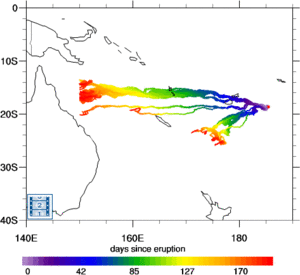Like a stone carried away by the current
Image of the month - January 2008
Trajectories of the pumice rafts produced during the 2006 Home Reef volcano eruption, calculated using altimetry combined with wind data to estimate and forecast the currents (click on the image to see the animation). (Credits University of New South Wales/Kingston University London/Yale University)
The Pacific is known for its volcanic hot spots, where volcanoes can rise out of the sea to create a brand new island in a day or so. During such eruptions, usually, a lot of pumice are thrown into the air. When in the middle of the ocean, these stones naturally fall down in the water. However, pumice is so light that it floats. When a lot of them are released at sea, they form a "pumice raft", that is carried away by the currents, and evolve as a recruitment vehicle for a wide variety of biota.
Pumice rafts were generated by a shallow marine explosive eruption on August 7-16, 2006 at the Home Reef volcano in the Tonga Islands. For the first time, pumice rafts were tracked and studied as they traveled across the Southwest Pacific to eastern Australia. Among the different studies of these rafts, modeling of their trajectories were improved, using altimetry. These improved trajectories were used to intercept the rafts at different stages, to examine pumice raft integrity and faunal recruitment. The rafts reached Fiji by end of September 2006 and Eastern Australia in March-April 2007.
See also:
- Image of the Month, February 2001: Where does all the waste go?
Websites on this subject:
- New Island and Pumice Raft, Tonga (Nasa Earth Observatory)
- photos of the new island and of pumice rafts





